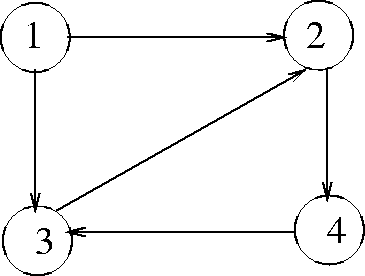


Next:7.1.1
Data Structures for Graph RepresentationUp:7.
Directed GraphsPrevious:7.
Directed Graphs
7.1 Directed Graphs
A directed graph or digraph G comprises
1. a set of vertices V
2. a set of directed edges or arcs, E (an arc is an ordered pair of
vertices)
Example: See Figure 7.1
Figure 7.1: A digraph with 4 vertices and 5 arcs
 |
V = {1, 2, 3, 4}
E = {(1,2), (1,3), (2,4), (3,2), (4,3)}
-
If there is an arc (v, w), we say w is adjacent
to v.
-
A path is a sequence of vertices v1,
v2,...vn such that the vertex pairs (v1,
v2),(v2, v3), ..., (vn
- 1, vn) are arcs in the graph. The length
of a path is the number of arcs on the path. A single vertex v by
itself denotes a path of length zero.
-
A path v1,
v2,..., vn is said to be simple
if the vertices are distinct, except possibly v1 and
vn. If v1 = vn and
n
> 1, we call such a path a simple cycle.



Next:7.1.1
Data Structures for Graph RepresentationUp:7.
Directed GraphsPrevious:7.
Directed Graphs
eEL,CSA_Dept,IISc,Bangalore

